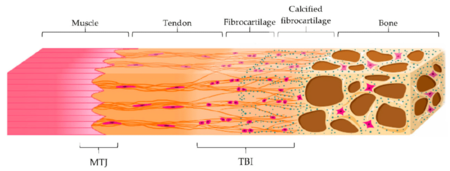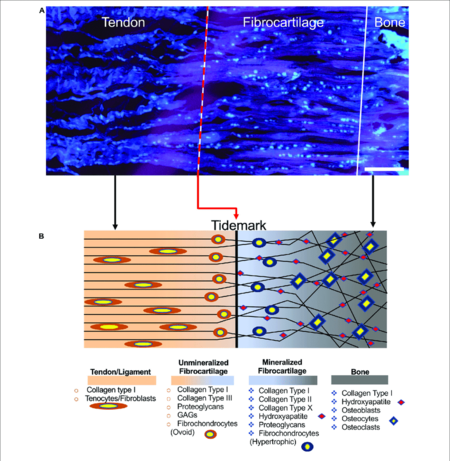Enthesis
The enthesis (plural entheses) is the interface between tendon/ligament and bone. See also about the myotendinous junction, the connection between muscle and tendon.
Structure and Function


The musculoskeletal system as a whole has both hard and soft tissues. The interfaces between these tissues have gradients in order to reduce stress concentrations at the junction sites. The interfaces between tendons/ligaments and bone are called entheses, while the interfaces between tendons and muscles are called myotendinous junctions (MTJ).
The structure of the enthesis varies widely depending on the location. There are two main categories of entheses: fibrous entheses, and the fibrocartilaginous entheses.
The function of the enthesis is to dissipate stress away from the interface.
Fibrous Enthesis
The fibrous enthesis attaches directly to bone. The term fibrous refers to the insertion being characterised by dense fibrous connective tissue which is similar to the tendon midsubstance.
It consists of tendons and ligaments being connected through acute angles to bones with collagen fibres extending directly from the periosteum, termed Sharpey's fibres.
This type of enthesis is commonly found in tendons that are attached to the diaphyses of large bones such as the deltoid insertion onto the humerus.
Fibrocartilaginous Enthesis
In this type of enthesis, there is a layer of fibrocartilage acting as a transition from the fibrous tendon to bone. The tendon is directly inserted into the bone and the tendon tissue close to the bone calcifies.
The fibrocartilaginous enthesis consists of a progressive mineralisation gradient that is organised into four zones. The boundary between the unmineralised and mineralised fibrocartilage zones is called the tidemark where there is an abrupt transition. The thickness of the junction is around 500 µm.
- Tendon/ligament: longitudinally oriented fibroblasts and a parallel arrangement of collagen fibres.
- Unmineralised fibrocartilage: contains various collagens (types I, II, III, X, IX) and proteoglycans (mostly aggrecans with associated chondroitin 4- and 6- glycosaminoglycans). The collagen fibres become increasingly randomly arranged. Fibroblasts and tenocytes are replaced by ovoid-shaped aligned fibrochondrocytes. It acts as a shock absorber to dissipate the stresses generated by the tendon. The mineralised fibrocartilage zone
- Mineralised fibrocartilage. There are hypertrophic chondrocytes surrounded by type II and X collagens and aggrecans. It is avascular and irregular. It provides the mechanical integrity of the insertion to provide for a transition of mechanical force across the insertion.
- Bone
The fibrocartilaginous type of enthesis is more common, and is also prone to overuse injuries.
Clinical Applications
A disease process affecting the entheses is called enthesopathy or enthesitis.
Common locations for injury are the rotator cuff, the anterior cruciate ligament, the Achilles tendon, the medial collateral ligament of the knee, tennis elbow, and jumper's knee.
Enthesopathy is also associated with spondyloarthropathies.
Further Reading
See Also
References
- ↑ Bianchi E, Ruggeri M, Rossi S, Vigani B, Miele D, Bonferoni MC, Sandri G, Ferrari F. Innovative Strategies in Tendon Tissue Engineering. Pharmaceutics. 2021 Jan 11;13(1):89. doi: 10.3390/pharmaceutics13010089. PMID: 33440840; PMCID: PMC7827834.
- ↑ Sensini, Alberto et al. “Tissue Engineering for the Insertions of Tendons and Ligaments: An Overview of Electrospun Biomaterials and Structures.” Frontiers in bioengineering and biotechnology vol. 9 645544. 2 Mar. 2021, doi:10.3389/fbioe.2021.645544

